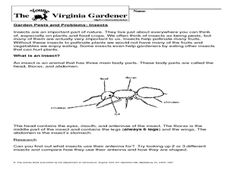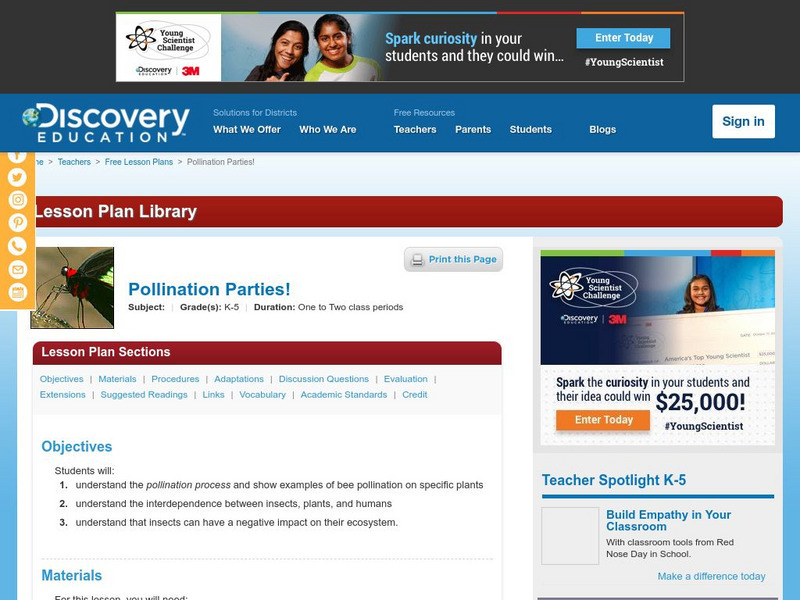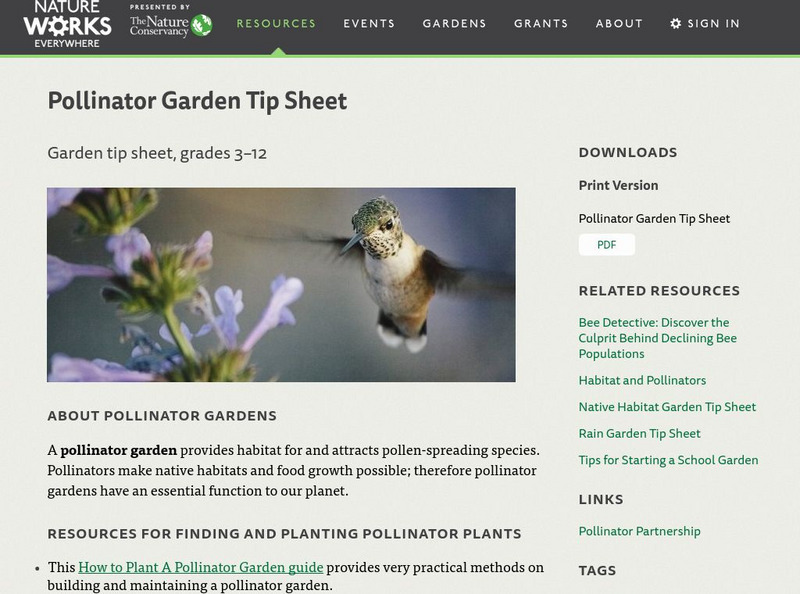Curated OER
Be A Bug Scout
Learners perform outside activities to determine the amount of insects, flowers, or common weeds within an area. They predict the number of insects they will find within their square area. Using calculators, students organize the data...
Curated OER
Fun with Flowers
Learners make observations of flowers. In this life science lesson, students look at flowers, then draw and color their favorite flowers. Lesson includes extension activities.
Curated OER
Painted Balsa-Foam Butterfly
Students research a butterfly and create butterfly art. In this visual arts lesson plan, students choose a specific butterfly to research and create a Balsa-Foam butterfly of the same species. Students use Balsa-Foam, modeling tools, and...
Curated OER
Bats are Our Buddies!
In this bats worksheet, students click on the links in the questions about bats to find the answers to the questions and then come back and answer the questions. Students answer 19 questions total.
Curated OER
Pollen Collection And Identification
Students investigate plant reproduction, pollen collection and identification. They collect pollen samples over a twenty four hour period and examine them under a microscope.
Curated OER
Flower Structure and Reproduction
In this flower structure worksheet, students read the information on flower structure and reproduction. Students answer questions based on the reading provided.
Curated OER
The Young Virginia Gardener: Garden Pests and Problems-Insects
In this garden pests and problems worksheet, learners read about insects and research what insects use their antenna for, comparing 2 or 3 different types.
Curated OER
Bat Facts
Student's demonstrate an understanding of basic facts about bats by creating a picture representation of bats in their habitat describing information they learned. The lesson is especially favorable for visual learners.
Curated OER
Exploring Bats
Third graders create a graphic organizer about bats in cooperative groups. The graphic organizer is used to illustrate the information that has been researched. The specific graphic organizer is the KWL.
Curated OER
IN STRAWBERRY FIELDS
The student will calculate wages of agricultural workers by the hour and by the piece.2. Share background material, and discuss the difference between gross pay and net pay and the difference between getting paid by the hour or the piece...
Curated OER
"In/Out Tables of Potential Crop Loss from Defoliation
In this economics worksheet, 4th graders use the data to determine the effects of crop loss due to defoliation from the effects of hail at different stages of growth.
Curated OER
Catch As Catch Can
Students capture and observe insects. Using provided netting, students design and create a butterfly net. They study many types of insects and their benefits. After identifying insects caught, students complete a graph. Students write...
Curated OER
Catch as Catch Can
Students investigate insects. In this insect analysis instructional activity, students catch insects using nets they make. They identify the insects they catch and create a chart to show the numbers and varieties. This instructional...
Curated OER
Spring Collecting and Identifying Bumble Bees
Students collect bumble bees in the field, record data, identify and release specimens, answer conclusion questions, and send data in to researcher leaders. They make research based conclusions based upon the evidence.
Curated OER
Butterfly Lesson
Students identify that Idaho is a home to 168 species of butterflies and they are an important part of many habitats. They also identify how to use the Digital Atlas of Idaho and write a report regarding information of their assigned...
Smithsonian Institution
Smithsonian Learning Lab: Plants and Animals: Partners in Pollination
Smithsonian Education presents a series of three lesson plans whose focus is plants and animals in their role as partners in pollination. Each instructional activity comes complete with clear learning objectives, materials list, subjects...
Other
Nature's Partners: Pollinators, Plants, and You [Pdf]
Teachers will love this comprehensive Grades 3-6 curriculum on pollinators. There are six modules of detailed plans and accompanying materials. Pre-assessment activities and teacher background information, as well as supplemental...
Discovery Education
Discovery Education: Pollination Parties
This activity helps students understand the concept of pollination. Objectives, materials, procedures, adaptations, discussion questions, evaluation, extensions, suggested readings, links, vocabulary, and academic standards are all...
Missouri Botanical Garden
Missouri Botanical Garden: Biology of Plants: Pollination
Learn the parts of a flower and how a plant gets pollinated. Includes video, songs, diagrams, and lesson plans.
Nature Conservancy
Nature Works Everywhere: Pollinator Garden Tip Sheet
Certain creatures help pollinate plants. This guide will help gardeners plant good pollinator plants.
CK-12 Foundation
Ck 12: Biology: Flowering Plants
[Free Registration/Login may be required to access all resource tools.] Describes the parts of a flower and the classification and evolution of flowering plants.
Smithsonian Institution
Smithsonian in Your Classroom: Plants and Animals: Partners in Pollination
A lesson unit on pollination. Includes background information, lessons and activity pages. One handout is in Spanish.
TED Talks
Ted: Ted Ed: How Bees Help Plants Have Sex
Fernanda S. Valdovinos explains how intricate pollination networks work and how it can all change from one season to the next. [5:25]
Cornell Lab of Ornithology
Habitat Network: Pollinators at Home: Intro to Pollinator Gardening
Find out how to provide native plants that foster the activity of insects and other pollinators.






















